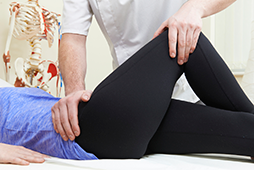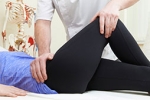
Your hips are one of the sturdiest joints of your body. For athletes, an injury to the hip could be career ending if treatment and therapy is not received in a timely manner. For the elderly, a hip injury could mean loss of independence and having to rely on others for personal needs. Here are a few common hip injuries and physical therapy exercises that may help resolve them:
- Hip pointer: An injury caused by falling on your side with the outer part of your hip hitting the ground first or by a direct blow to the upper part of the pelvic bone (iliac crest). While this may not be a very serious injury, it can be quite painful.
- Hip flexor strains: An injury to any of the muscles that flex the hip – usually it is the iliopsoas. Sprinting and kicking are the most common causes of hip flexor strain. Pain is felt in the groin or front of the hip.
- Hip Bursitis: Hip bursae are small sacs which contain lubricating fluid that act as shock absorbers between articulating surfaces of the hip. These sacs may become inflamed due to overuse from long distance running, trauma, poor posture, arthritis and similar conditions.
Immediately after a hip injury, wrap some ice in a damp cloth and apply it to the injury site for 15-20 minutes at a time 3-4 times a day for the first 1-2 days. After 2 days of rest, you can try the following physical therapy exercises to aid in recovery. The first 4 exercises may be used to hasten your recovery from minor hip pointers or hip flexor strains, while the last 2 exercises will help resolve minor cases of hip bursitis.
- Rotational lunge stretch: Start from a lunge position with the left foot forward and the right hand on the ground. While contracting the back glute, rotate your trunk as far as possible attempting to point towards the sky with your left arm. Hold this position for 2 seconds and then repeat.
- Lateral lunge: From a standing position, step to the side with the right foot. Your feet should be flat on the ground with toes pointing forward. Keep your left leg straight as you squat through your right hip. Without standing up, shift your weight to the left hip while straightening your right leg.
- Quadruped rocking: Get down on your hands and knees. Move your hips backwards as far as possible while maintaining the natural curvature of your spine. Stop when you start to feel your pelvis rotating and return to the starting position.
- Leg cradle: While standing, lift your right leg off the ground. Place your right hand under your knee and your left hand under your ankle, and pull your leg as close to your chest as possible.
- Glute bridge: Lie on your back with your knees bent. Lift your hips off the ground until your shoulders, hips, and knees are in a straight line. Hold for 2 seconds and then return to starting position.
- Side lying hip rotation: Lie on your side with your hips and knees bent, and your heels in line with your hips and torso. Rotate your hips so that your upper knee is pointing to the sky. Your heels should remain in contact with each other during this movement. Slowly lower your knee to the starting position.
If your hip injury does not improve after rest and the above exercises, or your hip pain is very severe, there could be a significant tear in the ligaments or tendons within the hip, perhaps even a fracture. In such cases, your doctor or an orthopedic specialist should be consulted. Once your condition has been accurately diagnosed and your doctor feels it is appropriate, you may be referred to a physical therapist near your residence to help quicken your recovery.
Dr. Domb is a nationally recognized orthopaedic surgeon specializing in sports medicine and arthroscopic surgery of the hip, shoulder and knee. A noted pioneer in advanced new techniques in hip arthroscopy, he delivers innovative treatments for patients with hip injuries such as impingement and labral tears. Dr. Domb is also an expert in arthroscopic surgery of the shoulder and knee, adept in specialized techniques including arthroscopic rotator cuff repair and all-inside ACL reconstruction.

